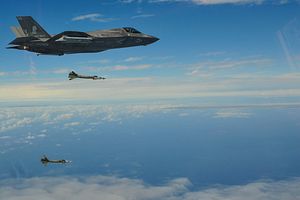F-35B fighters, the U.S. Marine Corps’ short take-off and vertical landing (STOVL) variant of the supersonic fifth-generation F-35B Lightning II Joint Strike Fighter, conducted bomb drops from the Wasp-class amphibious assault ship USS Wasp (LHD 1) in the Philippine and East China Seas this week, according to a statement by the U.S. Indo-Pacific Command.
The aircraft, armed with CATM-9X air-to-air missiles, dropped laser-guided Guided Bomb Units (GBU)-12 Paveway IIs and satellite-guided GBU-32s. The GBU 12 and GBU 32 are general purpose bombs weighting 510 pounds (230 kilograms) and 1,013 pounds (460 kilograms) respectively.
“We conducted these missions by launching from the USS Wasp, engaging role-player adversary aircraft, striking simulated targets with internally and externally mounted precision guided munitions, returning to the Wasp, and recovering via a vertical landing – a niche capability of the F-35B,” Lieutenant Colonel Michael Rountree, the F-35B detachment officer-in-charge aboard the USS Wasp. “This was the first time that this level of training has been performed by an operationally-deployed F-35B detachment with the 31st [Marine Expeditionary Unit].”
The F-35B conducted its first close air support strike in Afghanistan last September dropping a GBU-32) Joint Direct Attack Munition (JDAM) weapon fitted on an external weapon pod of the fighter. The F-35B took off from the Wasp-class amphibious assault ship USS Essex cruising in the Arabian Sea. Notably, the unit price for the F-35B recently went down, according to Lockheed Martin. Japan is expected to procure dozens of F-35Bs in the coming years.
The USS Wasp is the size of a small aircraft carrier and can carry around 31 military aircraft including the AV-8B Harrier IIs, MH-60S Knighthawk helicopters, AH-1Z Viper helicopters, and MV-22 Osprey tiltrotor aircraft. In 2017, the Wasp was retrofitted to be able to accommodate six F-35Bs. The amphibious assault ship and its escort and support vessels conducted a“ cooperative deployment” with the Japan Maritime Self-Defense Force amphibious transport dock JS Kunisaki in the East China Sea in January. The exercise was meant to test the ability of both ships to maneuver and communicate with one another.
The USS Wasp expeditionary strike group (ESG) arrived at the naval port of Sasebo, Japan, in January 2018, replacing its sister ship USS Bonhomme Richard as the biggest forward-deployed amphibious assault ship in the U.S. Navy’s 7th Fleet. The lead ship of the U.S. Navy’s newest class of amphibious assault ships, the 45,000-ton USS America, designated Landing Helicopter Assault (LHA) 6, will deploy to Japan by May 2019 to replace the USS Wasp. The USS America can reportedly carry up to nine F-35Bs.

































